FIVE HAT
SIGNERS
YOU PROBABLY DON'T KNOW
(But Who Had Very Interesting Lives)
THE
ALMOST
STAR:
JOHN LODGE
John Lodge and his wife, Francesca Braggiotti, in
Hollywood in the
1930s.
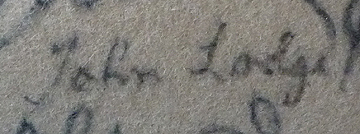 John
Lodge
John
Lodge
John
Lodge, born in
1903 to an uber-patrician and uber-political
family (his
older brother,
by a year, was Henry Cabot Lodge, a U.S. Senator,
Ambassador and
Nixon's 1960 vice-presidential running mate and his
grandfather had
been a famous U.S. Senator as well) is emblematic of
those for whom
Hollywood was just a brief stopover. Educated
at Harvard
University and Harvard Law School, Lodge married
Italian-born
actress/dancer Francesca Braggioti in 1929.
While he toiled
at a NYC law firm, Francesca took a 6-month job being
the Italian voice
of Greta Garbo in movies such as "Grand Hotel" and
"Mata Hari" being
prepared for release in Italy. The dubbing job
required her
to relocate to Los Angeles, and John joined her during
his summer
vacation in 1932. Being "tall, dark and
handsome" and having
a background in amateur college theatrics, John came
to the notice of
Paramount talent scouts, who initially offered a
standard $75 week
contract. He declined. When they upped the
offer to
$275 a week (way more than what he earned in law), he
agreed.
From all reports, his family was not amused.
Mae West, a
huge
Paramount star at the time, wanted him as her co-star
in "She Done Him
Wrong." But Lodge, presumably aware of how a
pairing with the
lascivious
West might really piss off his family, demurred,
asking to be cast in
supporting roles first. Paramount's mind, as you
can imagine,
boggled. Although he appeared in 22 films over
the next 9
years - most notably "The Scarlett Empress" opposite
Marlene Dietrich,
and in "The Little Colonel" as Shirley Temple's father
- Lodge had
missed his one shot at the brass ring on the Hollywood
merry-go-round.
(By the way, Cary Grant played the role in "She Done
Him Wrong" and
became an overnight sensation.) Lodge moved back
to NYC and
appeared in the hit Lillian Hellman play, "Watch on
the
Rhine." Then World War II happened.
John served
with
distinction, achieving the rank of Lieutenant
Commander in the Navy,
and when the War was over, he and Francesca settled in
Westport,
Connecticut whereupon he ran as a Republican for U.S.
Congress. He won in 1946, joining a freshman
class that
included John F. Kennedy and Richard Nixon, and was
re-elected in
1948. Two years later, he successfully ran for
Governor of
Connecticut. During his term, one of the hot
button issues
was the construction of the Connecticut turnpike,
which cut through
some rockbed Republican towns. Local legend has
it that the
turnpike turmoil cost him some Republican support when
he ran -
unsuccessfully - for reelection in 1954. If
true, I'm sure it
was no small irony that the turnpike was renamed The
Governor John
Davis Lodge Turnpike in 1963.
Lodge
spent
much of
the next three decades as a U.S. Ambassador, appointed
by a series of
Republican Presidents - to Spain from 1955-61, to
Argentina from
1969-74 and to Switzerland in 1983-5. Nice
postings.
His
brother Henry got the booby prize posting of the 20th
Century - South
Vietnam from 1963-4 and 1965-7 during the U.S.
military build-up there.
John Lodge died in late 1985 and is buried in
Arlington National
Cemetery.
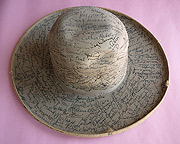
OSCAR
ANOMALY:
HAL MOHR

Hal
Mohr, Errol Flynn, and director Michael Curtiz
on the set of "Captain Blood" in 1935.
 Hal Mohr
Hal Mohr
 Evelyn Venable
Evelyn Venable
Hal
Mohr (1894-1974),
one of the few cinematographers to have a Star on
Hollywood Boulevard's
Walk of Fame, has a unique distinction. He's
the only person
to ever win a competitive Oscar as a write-in
candidate. Mohr
won for his work on 1935's "A Midsummer Night's
Dream," and immediately
thereafter, the Academy forever banished the
write-in option.
Hal got an Academy Award the "regular" way 8 years
later for his color
cinematography on "The Phantom of the Opera."
Fascinated
by cameras
at an early age, Mohr built his own movie camera and
started filming
short subjects while still a teenager in San
Francisco. The
Motion Picture Patents Company, a monopolistic trust
started by Thomas
Edison, actually confiscated his camera, citing
violation of their
patents. Mohr served in WWI and stayed in
Paris for another
year studying the technical aspects of European
film-making.
When he moved to Hollywood, he very quickly became a
recognized
cinematographer, racking up well over 100 credits
including such
classics as "The Jazz Singer," "The Front Page,"
"State Fair" (the
first one with Will Rogers), "Captain Blood," "Green
Pastures," "Destry
Rides Again," "A Watch on the Rhine," "Rancho
Notorious," "A
Member of the Wedding" and "The Wild One."
He
was married for 40
years to Evelyn Venable, a 1930's ingenue, who was
the original model
for the "lady-with-a-torch," the logo that opened
all of the Columbia
Pictures films and the voice of the Blue Fairy in
Disney's "Pinocchio."
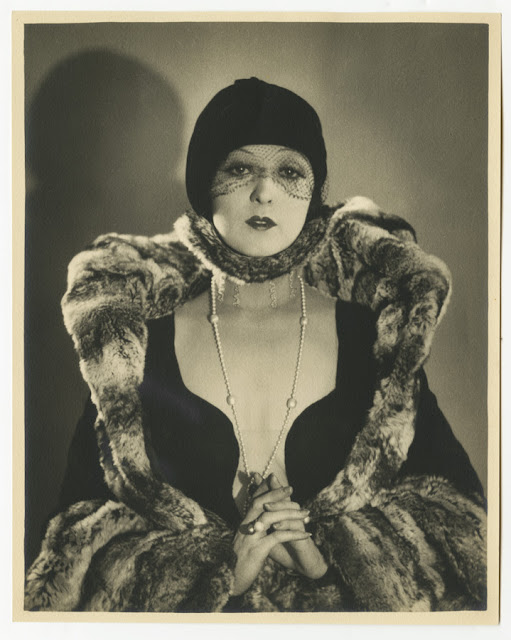
Mary Duncan in
1929.
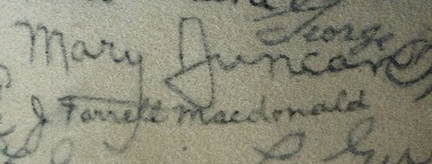
Mary Duncan
Mary
Duncan made her
Broadway debut at age 15 in 1910, but it was
another 16 years
before she scored in a theatrical hit, "The Shanghai
Gesture." Hollywood came calling and she
starred in a number
of silent movies. After talkies came in, she
played
substantial supporting roles. One of these was
in 1931's
"Five And Ten," in which Duncan is Marion Davies'
rival for the heart
and hand of Leslie Howard. Davies's real-life
paramour,
William Randolph Hearst, was the producer, so I
think you can guess who
won.
During the
filming of
"Five and Ten," Davies and Duncan became BFFs, and
at a polo match in
1931, Davies introduced Duncan to Stephen "Laddie"
Sanford, a very
wealthy international polo player (he'd been Time
Magazine's first
"sportsman" cover boy on March 31, 1923) and
director of the
Bigelow-Sanford Carpet Company. Duncan was 36
at the time,
and her biological clock as an actress was
ticking. By the
age of 40, most actresses' gilded carriages of a
career turn into
pumpkins, or in other words -- mother roles.
It was probably
a good time to plan an exit from her career.
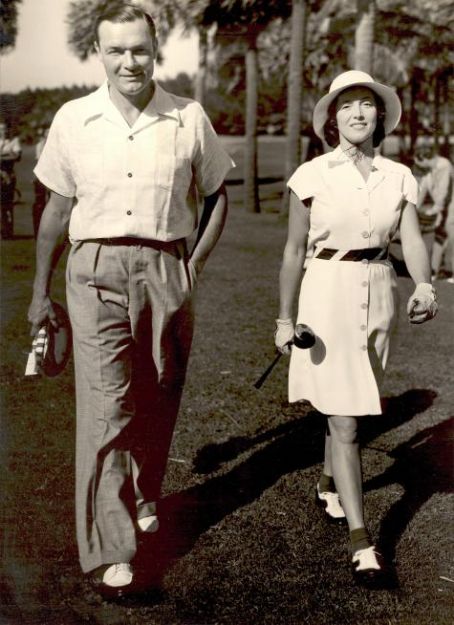
Stephen and Mary Sanford golfing in Palm Beach,
circa 1940s.
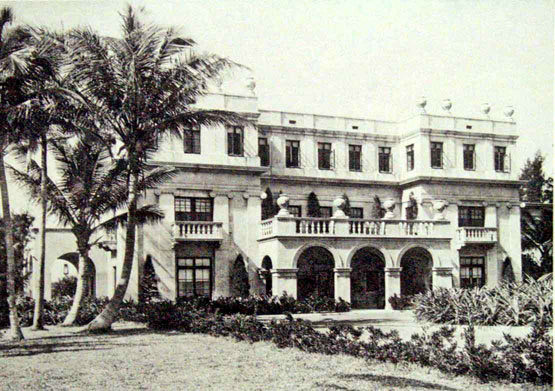
Los
Incas - the Sanford estate in Palm Beach.
And
it was a great
time to fall in love. Mary and Laddie courted
for two
years. Duncan performed her last role, in the
1933 Katharine
Hepburn Oscar winner, "Morning Glory," then married
Sanford.
Their permanent base was a fabled 40 room mansion in
Palm Beach,
Florida, called Los Incas, modeled after a palazzo
on Venice's grand
canal. But they had 3 other homes in New York
social centers
- Saratoga, Westbury and New York City. And
there was a vast
ranch near Orlando (which was later sold to Disney
when property was
being assembled for Disneyworld; she savvily took
the sale price in
stock, not cash).
Duncan
introduced the
novel concept of physical exercise to other Palm
Beach matrons - she
swam daily and liked to golf and play tennis.
Mary was also a
legendary hostess, entertaining the likes of the
Duke and Duchess of
Windsor and her bud, Rose Kennedy. She was
devoted to
Laddie, and when he was physically devastated by a
stroke, she nursed
him for 20 years until he died in 1977.
Mary was a
champion
fund raiser and event planner for charities.
She was in
charge of the annual American Cancer Society Ball in
Palm Beach and the
April in Paris Ball in New York - both high points
of the social season
- for decades, raising millions of
dollars.
Cinderella didn't just get to go to the ball.
She ran it.
By the time
Mary
Duncan died in her sleep in 1993, she was almost 98
years old and had
been the undisputed and beloved grande dame of Palm
Beach society for
as long as anyone could remember.
THE
MOST
FAMOUS SINGER
YOU'VE NEVER HEARD OF:
RUSS COLUMBO
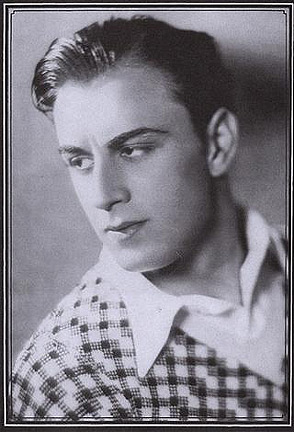
Russ Columbo - The Romeo of the Radio
 Russ Columbo
Russ Columbo
If
they made the story of Russ
Columbo's life as a movie
(and many, including Tom Cruise and Tony Curtis have
been considered
for it), you'd never believe it.
He was born
in 1908 as
Ruggerio Eugenio di Rodolpho Colombo in Camden, New
Jersey, the 12th or
13th child of musically-minded Italian
immigrants. He was
given violin lessons as a kid, declared a prodigy
and began to perform
professionally at 13, just after the family's move
to San
Francisco. By his late teens, he'd moved to
Los Angeles,
where he had gigs playing music on the sets of
silent movies to get
actors into the right mood. There, his
handsome
"Mediterranean" features caught the eye of screen
vamp Pola Negri, who
was struck by his resemblance to Valentino. (Negri
practically had a
second career claiming to be Valentino's last
lover.)
Negri and Columbo (the new spelling of his last
name) became
romantically involved and she assisted him in
landing small screen
parts.
In 1929,
Gus Arnheim,
whose nationally known orchestra was the "house
band" at the famed
Coconut Grove nightclub in Los Angeles, hired Russ
as a violinist and
as a standby for featured vocalist Bing Crosby,
whose drinking
sometimes rendered him unfit for microphone
duty. In no time
at all, Crosby left for bigger things and Columbo
was in, singing on
Arnheim's recordings and filmed shorts.
Columbo
specialized in
delivering love songs in a dead serious heartfelt
manner - dreamy
ballads that spoke of unrequited love or love gone
wrong.
Today, some call them "victim songs." And he
practiced what
he sang. Russ was always falling in
love. The press
dubbed him a "crooner," and likened him to Bing
Crosby. But
his ardent delivery was not at all akin to Crosby's
diffidence. No matter to the press: all
crooners
were alike.
He struck
out on his
own early in 1931 and struggled until he came under
the management of
songwriter Con Conrad (who would go on to win the
first Best Song Oscar
ever given for co-writing "The Continental" for
Astaire and Rogers'
"The Gay Divorcee"). A fast talker, Conrad
moved Columbo to
NYC and arranged contracts for, almost
simultaneously, an NBC radio
show, an open-ended engagement at the Brooklyn
Paramount Theater and an
RCA recording contract. More importantly,
Conrad created, for
the benefit of dozens of newspaper columnists, a
fictitious rivalry
between Crosby and Columbo and called it the Battle
of the Baritones.
The fake
rivalry
filled the newspapers on a daily basis, and
Columbo's star rose very
fast - with big record and sheet music sales
following. The
sheet music sales are important because Columbo was
also a gifted
co-writer of love songs - including "You Call it
Madness (I Call It
Love)," which was Russ' theme song, and the standard
"Prisoner of Love"
(later recorded by everybody from Frank Sinatra (who
owes a great deal
of his early style to Columbo) to Perry Como to Etta
James to James
Brown). He was called the "Romeo of the
Radio," and seemingly
overnight, he'd become a household name.
Conrad's
management
was less than ideal for Columbo, and when they
parted ways, Russ went
into a year-long slump, which saw him first tour
with his own band
(including sidemen Benny Goodman and Gene Krupa) and
then return to Los
Angeles. But, he bounced back with a new radio
program, a new
girlfriend - actress Carole Lombard - and contracts
to star in movies
for both Universal and 20th Century (Universal
planned to star Columbo
as Gaylord Ravenal in their production of
"Showboat").
Everything was going his way, and there was every
indication he was
going to be a gigantic star in multiple media.
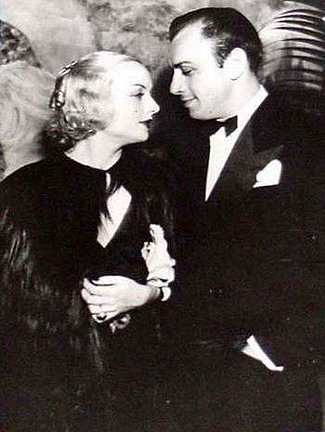
Carole
Lombard and Russ Columbo
On
September 2, 1934,
Columbo had a photo sitting at the Beverly Hills
house of his good
friend, photographer Lansing Brown.
Afterwards, as they sat
around talking, Lansing struck a match for his
cigarette against the
metal part of a Civil War pistol. The flame
set off an
unknown powder charge in the gun and it fired a lead
ball; it first
struck a table, then ricocheted and pierced
Columbo's left eye before
lodging in his brain. Rushed to the hospital,
he
astonishingly clung to life for 6 hours in the
hospital before dying.
Russ Columbo was only 26 years old.
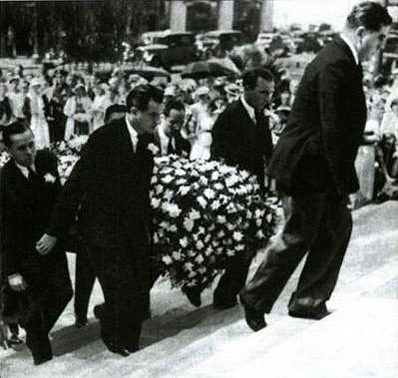
Bing
Crosby was a pallbearer at Russ Columbo's
funeral
(he's the first man on the far side of the
casket).
His
funeral was
attended by thousands and Lombard arranged for his
casket to be covered
with a blanket of gardenias. One of the
pallbearers was Bing
Crosby. And the story should end there, but it
doesn't. Here's the kicker: Columbo was
very close
to his mother. Two days before Russ' death,
his mother
suffered a stroke, and her doctor feared that news
of her beloved son's
passing would kill her at once. So, the
Columbo family
concocted a story that Russ had left suddenly for a
long-term booking
in England and arranged to have letters from Russ,
addressed to his
mother, appear with regularity. They got
Carole Lombard to
write to Mrs. Columbo, too, telling her that she and
Russ were married
and very happy. The family kept newspapers out
of the house,
and censored what radio programs could be
played. Russ's
London gig turned into an extensive European tour.
This
went
on for 10
years, until Mrs. Columbo finally died.
Reportedly her last
words were "Tell Russ I am so proud…and happy."
NOBLE
IS AS NOBLE
DOES:
NOBLE JOHNSON
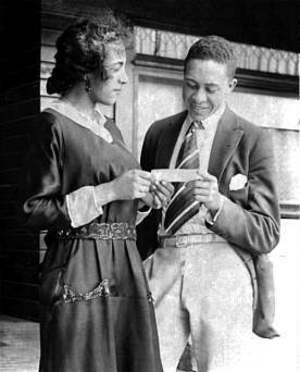
Noble
Johnson

Noble Johnson
Noble
Johnson, an
African-American, was born in Missouri in 1881, but
moved to Colorado
Springs, Colorado at a very early age, where he
became good
friends with
classmate Lon Chaney. They became pals all
over again once
Noble entered the film business in Los Angeles.
How and why
Johnson
entered the film business is the fascinating part of
his
story. In 1915, Noble was acting in the Omaha,
Nebraska
area. He, and his brother George, a Postal
worker, started a
business called the Lincoln Motion Picture Company,
the aim of which
was to film stories that portrayed African-Americans
as real and
"normal" and not as the racist depictions which were
then the
norm. This was the first African-American
owned film
production company, and the first movie company to
portray
African-Americans in a positive light.
Earlier in
1915, D.W.
Griffith's epic "The Birth of a Nation" premiered
and quickly became
the most successful movie released up to that
time. It was
also the center of enormous controversy sparking
riots in major U.S.
cities
because this Civil War and Reconstruction-themed
blockbuster unfairly
presented African-Americans as stupid and cowardly
(among other
unattractive attributes) and the Ku Klux Klan as a
band of heroes.
Undoubtedly,
the
formation of the Lincoln Motion Picture Company was
the Johnson
brothers' reaction to "The Birth of a Nation."
They moved to
Los Angeles later that year and set up shop.
To help pay for
production of what were to become known as "race
films," Noble started
acting in movies, and by the following year, Lincoln
released their
first film, "The Realization of a Negro's Ambition,"
the story of an
African-American young man - a civil engineer - who
gets his chance to
work in his chosen profession after rescuing the
white daughter of an
oil field owner.
That same
year, in no
small irony, Noble had a part in D.W. Griffith's
"Intolerance,"
Griffith's cinematic ode to tolerance partly made to
atone for the sins
of "The Birth of a Nation."
Throughout
the Teens,
Johnson performed in more than 30 movies and plowed
much of his
earnings into the cost of further production at
Lincoln. Two
more Lincoln films came out in 1917 - "The Law of
Nature" and "Trooper
of Company K, " about the near-massacre of an all
African-American
cavalry unit during the unofficial U.S. invasion of
Mexico in pursuit
of
Pancho Villa. Both were box
office successes with African-American
audiences. One more
picture was released in 1919 - "A Man's Duty,"
before Noble reluctantly
withdrew from Lincoln. He simply couldn't run
a film company
and pay attention to his very busy acting career.
And
Johnson's acting
career was pretty much non-stop. Because of
the peculiarities
of the film stock used in silent pictures,
African-Americans didn't
necessarily come out on developed film as
African-American.
Noble was also able to play Hispanics and Arabs and
Asians and American
Indians. He was a casting director's
dream.
Throughout the silents era of the 1920's, he had
featured roles in such
classics as "Four Horsemen of the Apocalypse," "The
Thief of Bagdad,"
"The 10 Commandments," "King of Kings" and "Robinson
Crusoe (Noble
portrayed Friday).
Johnson
made the
transition to talkies without a blip, a breath or a
pause. He
played Queeg-Queeg to John Barrymore's Captain Ahab
in "Moby Dick," the
Nubian in "The Mummy" and perhaps the role for which
he's most famous -
the Tribal Chief in "King Kong" and the sequel "Son
of Kong."
One of his last roles was in John Ford's 1948 "She
Wore a Yellow
Ribbon," in which he was cast as Chief Red Shirt.
In 1950,
Noble Johnson
retired to Yucaipa, at the foot of the San
Bernardino National Forest,
60 miles east of Los Angeles. In 35 years, he
had appeared in
approximately 150 films. He died in 1978 at
the age of 96.

|